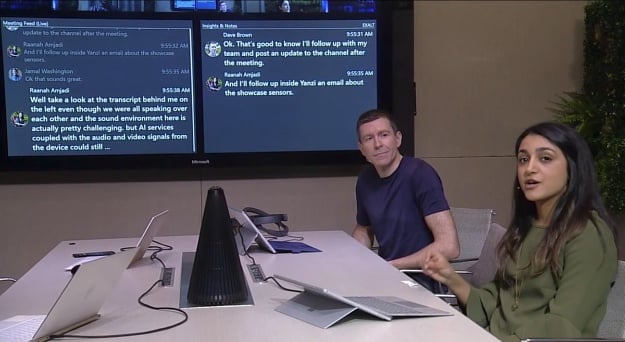Microsoft's AI-Powered Meeting Room Of The Future Is Amazing And A Little Creepy
The device, which is shaped like a cone, is equipped with a 360-degree camera and a powerful microphone array. The camera uses facial recognition to scan the room and identify meeting participants. The microphones are used to pick up their voice and transcribe everyword spoken in a meeting in real-time using Microsoft's AI software. The voice recognition/transcription works with any language, which is helpful for companies where employees are working with teams that may be scattered across the globe.
Such a device will be completely integrated into Teams, which is Microsoft's increasingly feature-packed competitor to Slack. The transcription feature of the device can handle the speech of multiple meeting participants in multiple languages simultaneously.
However, the fact that this system can identify meeting participants and automatically transcribe their every spoken word for future reference might bring some embarrassing side effects, as this Twitter response makes clear:
Microsoft's meeting prototype device was cool, but what happens if every random comment you make in a meeting is transcribed and preserved for anyone to see? I guess it's a good way to make sure meetings stay on topic.. pic.twitter.com/qTBRo7CX8i
— Karissa Bell (@karissabe) May 7, 2018
Microsoft is no stranger to this type of transcription service, as Skype has integrated similar functionality for quite some time. The Skype Translator was first launched in 2014, and most recently enabled translation features for Skype calls to mobile phone and landlines. Last year, Microsoft announced that its AI division was making great strides in improving speech-to-text operations.
“Being able to have software now that observes people, listens, reacts and is knowledgeable about the physical world around them provides an excellent breakthrough in terms of making interfaces more human, more natural, more easy to understand and thus far more impactful in lots of different scenarios," said Mike Seltzer, a principal researcher in the Speech and Dialog Research Group at Microsoft’s research lab in February 2017.
Regardless of some the quirks that may pop up with an eventual production version of this system, it's clearly a forward-looking approach to making (and keeping track of) meetings more bearable for everyone involved.


